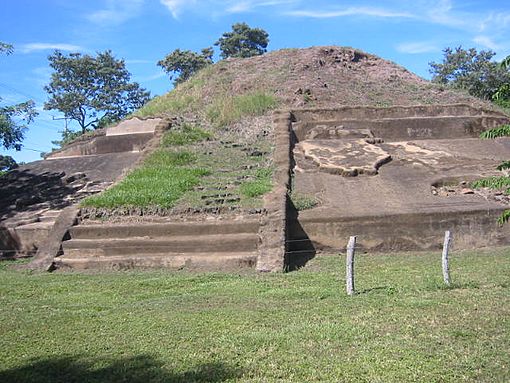Casa Blanca, El Salvador facts for kids
Casa Blanca is an ancient Maya site in El Salvador. It is a special place where people lived long ago, before Christopher Columbus came to the Americas. This site is in a town called Chalchuapa.
Casa Blanca has several large pyramids. These pyramids were built a very long time ago. Some are from the Late Preclassic period (about 500 BC to AD 250). Others are from the Classic period (AD 250 to 900).
This ancient ruin is part of a bigger area called the Chalchuapa archaeological zone. You can see influences from other important ancient cultures here. These include the Olmecs and people from Teotihuacán. Casa Blanca is also connected to other nearby ancient sites like Tazumal and San Andrés.
The government bought the land where Casa Blanca is in 1977. It was named after the coffee farm that used to be there. There are many pyramids at Casa Blanca, but only two have been partly rebuilt. Casa Blanca is in the Santa Ana Department of El Salvador.
Currently, Casa Blanca is closed to visitors. This is because workers are busy restoring the site. It also has a museum where you can see ancient Maya pottery and other cool artifacts.
Contents
What is Casa Blanca?
Casa Blanca is an important archaeological park. It shows us how ancient Maya people lived. It helps us understand their buildings and way of life.
Why is it called Casa Blanca?
The name "Casa Blanca" means "White House" in Spanish. This name comes from the coffee plantation that was on the land before it became an archaeological park.
History of Casa Blanca
The history of Casa Blanca goes back thousands of years. People lived here for a very long time.
Early Settlements (Preclassic Period)
The oldest parts of Casa Blanca are from the Late Preclassic period. This was from about 500 BC to AD 250. During this time, the Maya people started building large structures. They also developed their unique culture.
Later Development (Classic Period)
The site continued to grow during the Classic period. This was from AD 250 to 900. More pyramids and buildings were added. This shows that Casa Blanca was an important center for many centuries.
Pyramids and Structures
Casa Blanca has several ancient pyramids. These were likely used for religious ceremonies or as homes for important leaders.
How Many Pyramids?
There are many pyramids at Casa Blanca. However, only two of them have been partly restored. This means they have been carefully rebuilt to look more like they did long ago.
What are the Pyramids Made Of?
The pyramids are made from earth and stone. They were built by hand by the ancient Maya people.
Influences from Other Cultures
Casa Blanca shows signs of being connected to other ancient cultures.
Olmec Influence
The Olmec people lived in what is now Mexico. They were one of the first major civilizations in Mesoamerica. Their ideas and art spread to other areas, including Casa Blanca.
Teotihuacan Influence
Teotihuacán was a huge ancient city in Mexico. It was one of the largest cities in the world at its peak. Its influence reached far and wide, even to Casa Blanca. This shows how connected ancient cultures were.
The Chalchuapa Archaeological Zone
Casa Blanca is part of a larger archaeological area. This area is called the Chalchuapa archaeological zone.
Other Nearby Sites
Within this zone, you can find other important ancient sites. These include Tazumal and San Andrés. Studying these sites together helps experts understand the region's history.
The Museum at Casa Blanca
Even though the site is closed for restoration, it has a museum.
What Can You See in the Museum?
The museum at Casa Blanca displays many artifacts. These include ancient Maya ceramics (pottery). You can also see other tools and objects that the Maya people used every day. These items help us learn about their lives.
Restoration Work
Casa Blanca is currently undergoing restoration. This means experts are working to preserve and rebuild parts of the ancient site.
Why is Restoration Important?
Restoration helps protect these old buildings. It also allows future generations to learn about the Maya people. It makes the site safer for visitors when it reopens.
Images for kids
See also
 In Spanish: Casa Blanca (sitio precolombino) para niños
In Spanish: Casa Blanca (sitio precolombino) para niños







